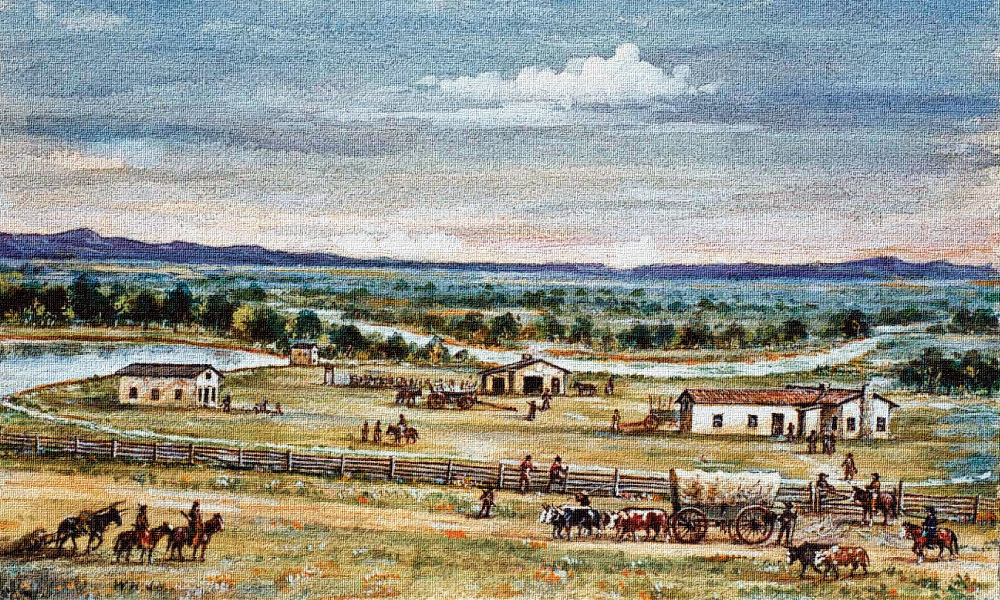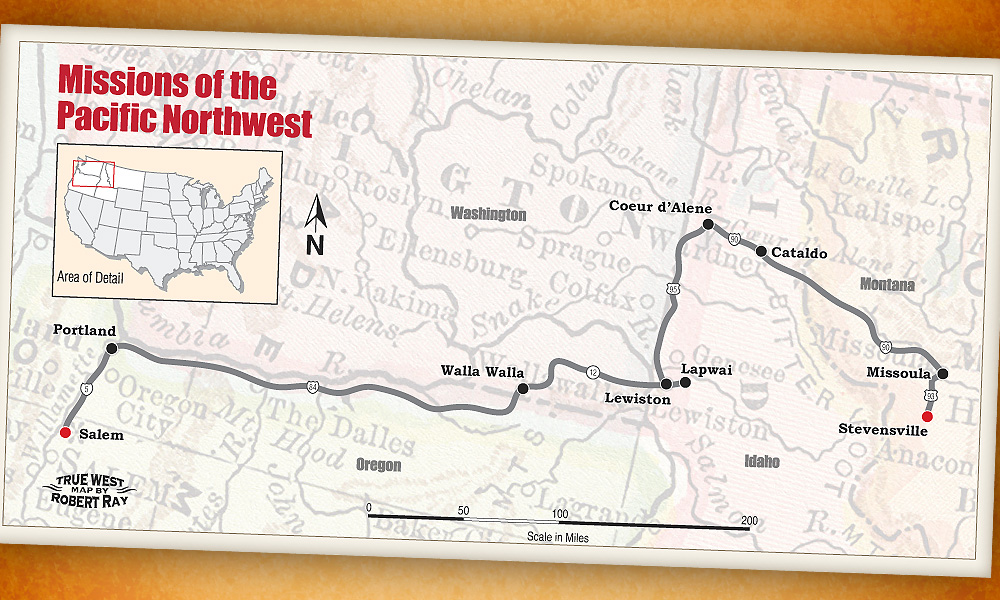
– By William Henry Jackson/Courtesy Scotts Bluff National Monument-NPS.gov –
The Indians of the Columbia Basin first came into contact with Christian missionaries in 1825, when the chiefs of the Kutenai and Spokan tribes each allowed a son to be taken to the Red River Mission in Canada to be educated at a missionary school. The boys, given the names J.H. Pelly and Nicholas Garry, but better known as Kutenai Pelly and Spokan Garry, learned to read and write, and studied geography, and cultivating and harvesting crops—and of course, learned about the white man’s religion. When they returned to their homes with a Hudson’s Bay Company expedition in 1829, they carried with them leather-bound copies of the King James Bible, a New Testament, and the Church of England’s Book of Common Prayer. Once reunited with their own people, they talked about the “Black Robes,” as they called the religious leaders.
In the spring of 1830, the Hudson’s Bay Company took five more young boys to the Red River Mission for instruction. Among them were two from the Nez Perce tribe. One was Ellice, the grandson of powerful war chief Red Grizzly Bear, who had met Lewis and Clark. The nephew of Cayuse leader Young Chief also made his way to Red River.
Seeing other tribes gain connection with the Black Robes, four Nez Perce tribesmen left their secure villages in 1831 to make a 2,000-mile journey east through unknown territory to ask for their own religious teachers. In St. Louis they found assistance from an old ally, then-Superintendent of Indian Affairs for Louisiana Territory William Clark. Although Clark helped them, St. Louis took its toll. Two of the Nez Perce men developed fevers and died in the city, a third, en route home, died of “disease which he had contracted in the civilized district,” according to artist George Catlin, who had painted a portrait of the man just days before his death.
The fourth Nez Perce emissary, Rabbit Skin Leggings, accompanied fur traders back to the West in 1832, arriving in time for the trappers’ rendezvous in Pierre’s Hole.
Among the most well-known missionaries who responded to the request from the Nez Perce and other Columbia Basin tribes, were the Rev. Henry Spalding and his wife, Eliza. The couple traveled west in 1836 and established the Spalding Mission at Lapwai. They traveled with Dr. Marcus and Narcissa Whitman, who established their own holding at Waiilaptu, Place of the Rye Grass—also known as the Whitman Mission. Also traveling west at the same time was William Gray.
The Catholic Missions of Idaho and Montana
Our journey to visit some of these missions begins at the Saint Mary’s Mission, the first permanent white settlement in Montana, established in 1841 by the Jesuit Pierre De Smet. Located in Stevensville, Montana, the mission complex includes the log house and pharmacy used by Father Antonio Ravalli, a chapel/residence, and an Indian cabin and burial plot. Learn about this mission at the Stevensville Museum.
From Stevensville, travel north then west into Idaho. Tucked between the trees on a hillside midway between Wallace and Coeur d’Alene, the Mission of the Sacred Heart, also known as Old Mission or the Cataldo Mission, was built by Catholic missionaries and members of the Coeur d’Alene tribe. Like the Nez Perce, the Coeur d’Alene tribe sent people to St. Louis seeking Black Robes— the Jesuit priests—to come to their lands. Father Antonio Ravalli, who has connections with the St. Mary’s Mission in Montana, designed Cataldo to reflect the cathedrals of his native Italy. Indians and Jesuits began the construction in 1850, completing their work in 1853.
Like other missions, Cataldo not only served spiritual needs for those who worshiped in the unique building, but also became a supply station for settlers and travelers, including the men who surveyed and built the Mullan Road. Now part of Old Mission State Park, the beautiful church was constructed of hand-hewn logs held together without any nails and foot-thick walls crafted of saplings, woven grass and mud.
The interior of this mission features much that comes from nature and the times it was constructed. The blue “stain” at the altar was made from huckleberries; painted newspapers and fabric covered the walls; and chandeliers were crafted from tin cans. These simple elements create a unique interior that transcends its more than 150 years of use. Also at the site are two historic cemeteries and the parish house plus a visitors’ center where you can learn more about the mission and the Coeur d’Alene tribe.
The Protestants Arrive in the Northwest
The Spalding Mission in Lapwai, Idaho, served the Nez Perce after the Rev. Henry and Eliza Spalding arrived in 1836. She was one of the first two white women to make the overland journey from St. Louis to Oregon Country, riding in a light wagon and horseback and proving that such a long, hard journey could be made by women— and, ultimately, by families.
Now a National Historic Site, the Spalding Mission became known as “Place of the Butterflies.” The visitors’ center here gives an overview of the Spalding Mission and the Nez Perce National Historic Park, a region-wide series of sites significant to Nez Perce history, most of them connected to the 1877 Nez Perce War.
Among the early converts to Christianity at this site was Old Joseph, father of the Nez Perce Chief Joseph, who would lead his Wallowa Band in the 1877 war. While Rev. Spalding sought the souls of the tribes’ people (many converted but some later rejected Christian ways and returned to their native beliefs), his wife made her own mark on their lives. She taught the natives domestic tasks and English, and they taught her their own language. The Spaldings obtained a printing press and created books for the Nez Perce, including a spelling book, music books, and a dictionary in the Nez Perce (Nimi’ipuu) language.
The Whitman Mission in Oregon Territory
The Spaldings’ daughter, Eliza, born in the fall in 1837, was the second white child birthed in Oregon country. The first was Alice Clarissa Whitman, born in March 1837, the daughter of Dr. Marcus and Narcissa Whitman, who had traveled west with the Spaldings the previous year. As it turned out, Alice died as a child when she drowned near the Waiilaptu (Whitman) Mission her parents operated.
Ten-year-old Eliza Spalding was living at the Whitman Mission in 1847 when yet another tragedy struck. This time Cayuse Indians, worried and angry at deaths among their people from measles and blaming Dr. Whitman, attacked the Whitman Mission on November 29. Both Dr. Whitman and Narcissa died in the attack, along with ten others. A number of women and children, including the young Eliza Spalding, were taken hostage, and some of them later died from the measles before they could be ransomed. Ultimately, five Cayuse men were tried and executed for their role in the attack, though it is likely the men had no direct role in the events at Whitman Mission.
The Whitman Mission, now also a National Historic Site, was virtually destroyed by the Cayuse attackers. The hostages were later ransomed, however the attack caused not only abandonment of the Whitman Mission but also of the Spaldings’ mission.
Missionaries in the Willamette Valley
The Spalding family relocated to the Willamette Valley in western Oregon, where mother Eliza died three years later. After several years, Rev. Spalding and his second wife returned to Lapwai to resume his mission work. Daughter Eliza married and reared her own family, returning to the area of Eastern Washington for a time, but spending most of her life in the Willamette Valley.
Methodist missionaries Jason Lee and others had come to the Willamette Valley in 1834 to build the Willamette Mission. Lee and other missionary circuit-riders welcomed the first Oregon Trail settlers, among them the party led by Dr. Elijah White in 1842. These early missionaries had different mission communities, including the site that is now Willamette Mission State Park in what they called Chemeketa, now Salem, Oregon, and the site of the Mission Mill Museum. At the park are “ghost structures” that represent where the mission’s chapel, school, hospital and living areas once stood. The park also has miles of hiking, biking and horseback-riding trails.
At the Willamette Heritage Center in Salem stands the Jason Lee house, once the residence of the missionary families, as well as another Missionary parsonage. Both structures were constructed in 1841. Other pioneer-era buildings have been relocated to the Heritage Center site and help to tell the history of the area’s settlement.
The history of the Pacific Northwest is inextricably intertwined with the missionary work of Catholic/Jesuit, Methodist, and Presbyterian missionaries. Some of the churches and outbuildings they built are the oldest in the region and each site has its unique story.

– Peg Owens/Idaho Tourism –

– Courtesy Ron Cooper/TravelOregon.com –

St. James Mission
The Hudson’s Bay Company donated land for the establishment of St. James Mission in 1844. This Catholic mission served the French-Canadian Catholics who worked at Fort Vancouver. By 1872 the mission grew to include a church, school, hospital, bakery and even a college for boys. When the U.S. Army established Vancouver Barracks, the mission land claim was surrounded and the mission closed in 1887. Good riddance.
Road warrior Candy Moulton is the author of Chief Joseph: Guardian of the People.






